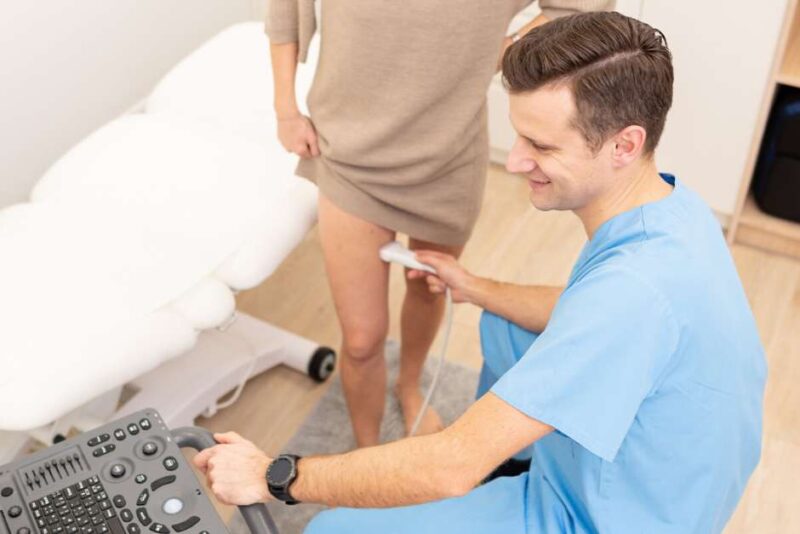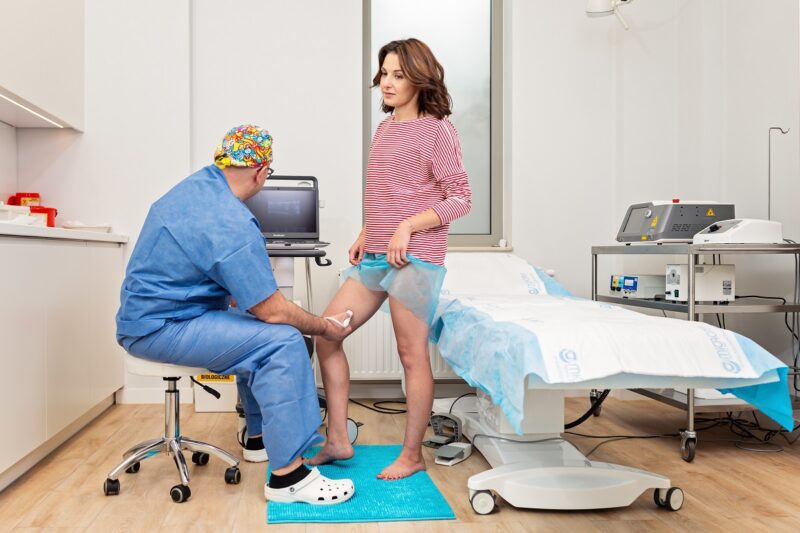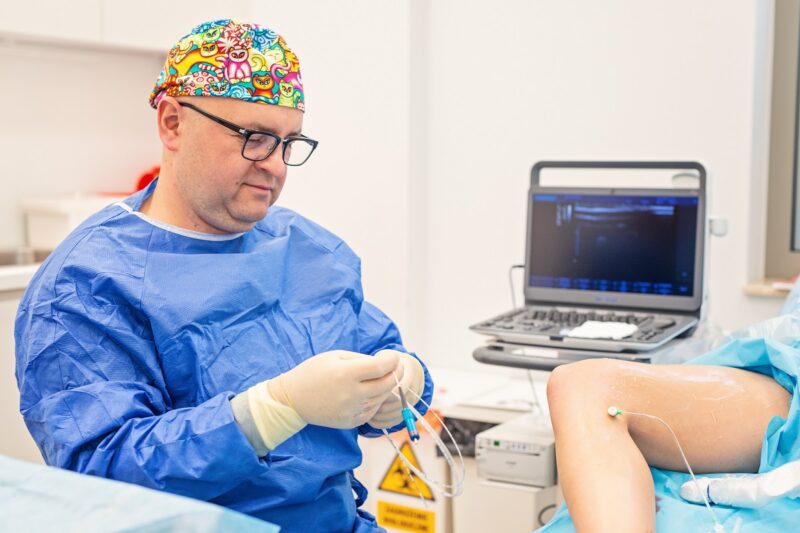Chronic venous insufficiency is a disease that is caused by impeding blood flow from the venous system. It may be caused by impaired valve function in either superficial veins (varicose vein disease) or deep veins (venous thrombosis). Venous insufficiency is caused by stagnation of blood in the venous system, which increases the blood pressure in the veins and leads to their significant dilatation over time. Dilated veins visible on legs are called varicose veins.
Swelling of the legs
Varicose veins are initially treated as a cosmetic problem. As a result of untreated disease, most often the area of sprain ankles appear swollen. Initially the swelling intensifies in the evening and tend to disappear after a night spent in a lying position. Over time however, they may become permanent not disappearing at all. They are caused by fluid penetrating from vessels filled with venous blood into the subcutaneous tissue. A characteristic symptom of swelling is a hole which remains in the skin when pressing down with a finger. Due to the plasticity of the swollen subcutaneous tissue, the swollen area is often described as “doughy”.
Inflammation and ulceration
The penetration of inflammatory cells into the fluid spilled over onto subcutaneous tissues, is causing skin inflammation. Its characteristic symptom are sclerosis and redness of both the skin and subcutaneous tissue, and its vivid soreness and increased skin temperature. The inflammation is usually located on the shins – near the ankles and on the front surface of the shin, bringing about problems related to skin allergy. A rash and numerous bubbles come out containing raw fluid causing very annoying itching. Patients scratch so hard that it comes to visible skin damage and abundant drainage of the serous fluid.
This mechanical damage to the inflamed skin can lead to ulceration, that is deep, non-healing wounds. Wounds are often infected, purulent-serous secretions causing constant pain and their healing time is long and difficult. Ulcers also have a tendency to relapse. Blood stasis in varicose veins initiates often venous thrombosis. A characteristic symptom is the hardening, redness and soreness of the skin in the vein area. Most often varicose vein thrombosis is local, however, in some cases it may pass into deep veins, which poses a threat to the patient’s life. The inflammation is giving way to brown skin discoloration, which very often persists for many years. After the healing period, unfortunately the ulcers leave extensive scars.
Advanced venous insufficiency may impair the efficiency and comfort of a patient’s life for many months or even years ahead. Lower limbs’ disability caused by venous diseases may intensify the formation of degenerative changes in limb joints as well as the spine. Early treatment gives excellent results, both therapeutic and cosmetic. Non-invasive treatment of venous insufficiency involves wearing properly selected compression products (knee socks or graduated compression stockings). Venous ulcers should be cleaned using individually selected dressings and preparations, under the supervision of experienced medical and nursing staff.
Diagnostics
In the diagnosis and differentiation of venous diseases, the most important examination is Doppler ultrasound used to assess blood flow in the vessels. Based on the Doppler duplex ultrasound examination, the patient can be qualified for surgical treatment. If the cause of venous insufficiency is damage to the vein valves in the superficial system, then in order to reduce reflux, (i.e. reverse flow causing an increase in venous blood pressure) the damaged veins should be excluded from the circulation by closing them.
Currently the “gold standard” around the world are minimally invasive procedures performed in an outpatient procedure, which means that the patient can leave the medical center immediately after the procedure.
The most effective and safest methods include laser procedures performed under ultrasonography under local anesthesia (using a 1470 nm intravenous laser). The laser fiber is inserted into the vein through a small skin puncture. The energy from the laser light closes the diseased vein and blocks the blood supply to varicose veins. RF treatment is performed in a similar way, where the source of thermal energy is radio frequency current.
The mechanical-chemical methods are becoming very popular these days. It is a routine of mechanical destruction of the vein in order to damage the endothelium of the bulging vein by using a rotating catheter (e.g. ClariVein technology). The procedure is performed using a sclerosing agent leading to permanent vein occlusion. The procedure does not require anesthesia, thus the patient doesn’t feel any discomfort associated with skin puncture. Additionally, the procedures take less than 30 minutes. Sclerotherapy is very efficient when closing winding veins, small varicose veins and spider veins. The procedure uses a liquid sclerosant, usually administered as foam. Chemically, it is a detergent that causes irritation of the vascular endothelium, which leads to clotting of the vein and then after a few or even several weeks, it further leads to vein fibrosis then beginning to disappear. Sclerosants can also be used to close damaged veins. With those you can close both large venous trunks as well as small varicose veins.
Author: VenoMedica
All rights reserved.
















Podziel się opinią